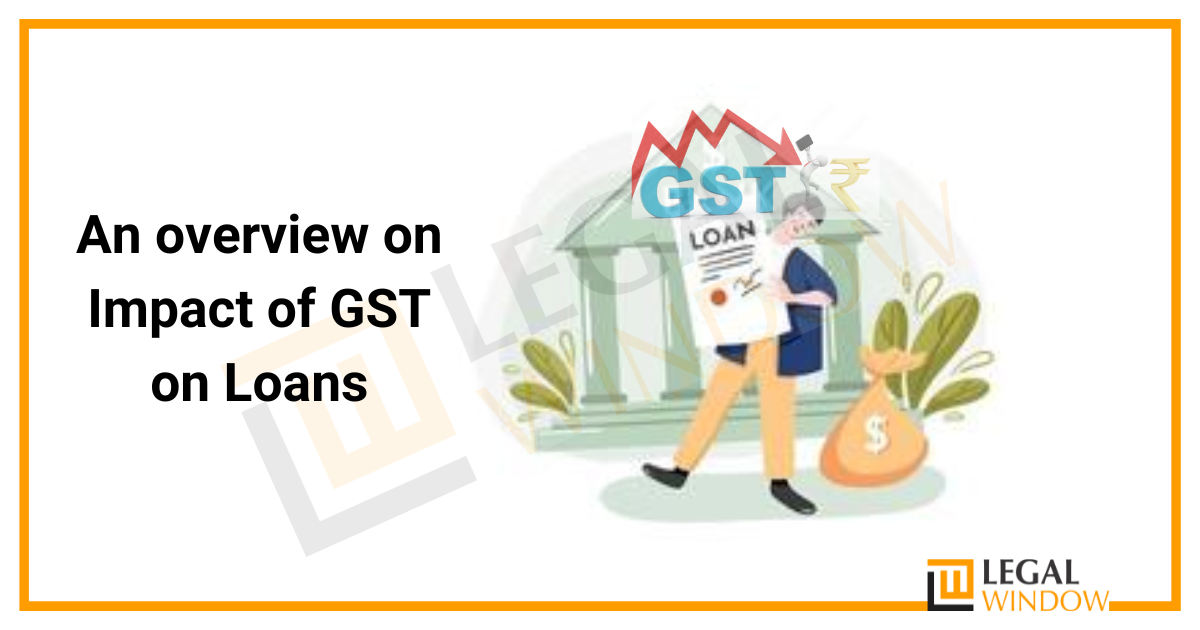
Goods and Services Tax (GST) was implemented in India on July 1, 2017, under CGST Act, 2017 with the aim of simplifying the taxation system and reducing tax evasion. The implementation of GST has had a significant impact on various sectors of the Indian economy, including the banking and finance sector including Loans. The implementation of GST has had a significant impact on loans in India. While the simplification of the tax structure has made it easier for businesses to calculate their tax liability, the increase in loan costs has made it more difficult for some borrowers to obtain loans. In this article, we will discuss the impact of GST on loans and how it has affected borrowers.
| Table of Content |
Short Glimpse
In order to harmonize the indirect tax system throughout the nation, India implemented the Goods and Services Tax (GST) on July 1st, 2017. A value-added tax known as the Goods and Services Tax (GST) is levied on goods and services consumed in India. It was intended to take the place of other indirect taxes like value-added tax (VAT), service tax, and excise duty.
Any company, individual, or corporation that provides products or services in India is required to register for GST. GST has a significant effect on the people, businesses, and economy of the nation. The introduction of the GST has altered the country’s taxation system. Loans are one sector where GST has had a big influence.
However, before we move on to discuss about Impact of GST on Loans, let us first delve into the concept of GST prevailing in India.
Understanding the concept of GST in India
Goods and Services Tax is referred to as GST. India implemented it as an indirect tax on July 1, 2017. Multiple indirect taxes have been replaced by the unified GST tax. that the Central and State governments historically imposed, including Central Excise duty, Service tax, Value Added Tax (VAT), and others.
At every point in the supply chain, the supply of goods and services is subject to the destination-based GST tax. Every step in the supply chain is subject to the tax, with the final consumer bearing the brunt of it.
By doing away with many taxes, lowering tax evasion, enhancing compliance, and encouraging ease of doing business, GST has simplified the tax system in India. By offering a uniform tax platform for all states and Union Territories, it has also aided in the unification of the Indian economy.
Types of GST in India
In India, there are primarily four forms of GST in use:
- The Central Government levies CGST (Central Goods and Services Tax) on intra-state transactions of goods and services.
- State Goods and Services Tax, or SGST, is a charge made by the state government on transactions for the exchange of goods and services inside the state.
- The Central Government levies a tax known as the IGST (Integrated Goods and Services Tax) on interstate transactions involving goods and services.
- UTGST (Union Territory Goods and Services Tax) is a tax imposed on intra-state transactions involving goods and services inside Union Territories of India by the Union Territory Government.
With the introduction of GST, the former system of numerous indirect taxes imposed by the Central and State Governments, including VAT, excise duty, service tax, and others, has been replaced. The adoption of the GST has streamlined the tax code and increased taxpayer transparency.
Who all are under obligation to pay GST?
In India, a consumption-based tax known as GST (goods and Services Tax) is imposed on the provision of products and services. With a few exceptions, most individuals and companies that provide goods or services are required to register for and pay GST.
In India, the following items are subject to paying GST:
- Businesses with an annual gross revenue of more than Rs. 40 lakhs (Rs. 10 lakhs for NE and hill states).
- Individuals or organisations that supply products or services between states.
- Operators of e-commerce who provide goods or services through their platforms.
- Businesses that are subject to the reverse charge system for tax payment.
- Those who sell goods or services in India on a temporary basis and non-resident taxpayers.
- People or Organisations that must deduct TDS (Tax Deducted at Source).
- Wholesalers of input services who give units eligible for the credit the GST paid on those services’ inputs.
However, some products and services are excluded, and some companies are exempt from registering for and paying GST. It is crucial to seek advice from a tax expert or study the official GST rules to ascertain whether GST registration and payment are necessary for a specific company or individual.
Advantages of GST
GST has a number of advantages for the Indian economy and its people, including some of the following:
- Simplified Tax Structure: The Central and State governments’ numerous indirect taxes have been replaced by the GST, which has simplified the tax system. This has lowered the difficulty of compliance and the cost of tax compliance for companies.
- Increased Tax Base: The GST has expanded the tax base by bringing more unorganised and small enterprises into the tax net.
- Reduction in Tax Evasion: By removing the cascading effect of taxes and requiring that taxes be paid at every stage of the supply chain, the adoption of GST has assisted in reducing tax evasion.
- Boost to Exports: Exports are now more competitive because of the GST’s lower manufacturing costs and the ability for exporters to get refunds for taxes they paid on materials used in exports.
- Encouragement of Ease of Doing Business: GST has made it possible for companies to register and file taxes online, which has decreased the amount of paperwork and administrative work.
- Tax Rate Uniformity: The GST has made sure that tax rates are consistent throughout the nation, boosting economic unification in India.
- Increase in GDP: By encouraging investment and growth, GST has the potential to raise the nation’s GDP by 1% to 2%.
Impact of GST on Interest Rates
One of the most significant impacts of GST on loans is on interest rates. Under the pre-GST regime, there were various indirect taxes such as excise duty, service tax, VAT, and others, which increased the overall tax burden on the borrower. With the introduction of GST, most of these indirect taxes have been subsumed, resulting in lower tax rates.
As a result, the overall interest rates on loans have come down, making it more affordable for borrowers to avail of loans. This has also led to increased competition among lenders, resulting in better loan products and services for borrowers.
Impact of GST on Processing Fees and Other Charges
Under the pre-GST regime, banks and financial institutions used to charge various fees such as processing fees, pre-payment charges, foreclosure charges, and others. These charges were levied separately and attracted different tax rates.
With the introduction of GST, all these charges are now subjected to a single tax rate, resulting in a uniformity of charges. This has made it easier for borrowers to compare loan products from different lenders and make an informed decision.
Impact of GST on Loans
GST has impacted loans in multiple ways, affecting both lenders and borrowers. Here are some of the key ways in which GST has impacted loans in India.
- Increase in the Cost of Loans: GST has led to an increase in the cost of loans in India. Before GST, service tax was levied on the interest charged on loans. However, with the implementation of GST, loans are now subject to an 18% GST rate. This means that borrowers now have to pay a higher tax rate, which has led to an increase in the cost of loans.
- Reduction in Input Tax Credit: Under GST, lenders can claim input tax credit for the tax paid on inputs used in the loan process. However, this credit is only available for certain types of loans, such as housing loans and vehicle loans. Other loans, such as personal loans and credit card loans, do not qualify for input tax credit. This reduction in input tax credit has increased the cost of these loans for lenders, which has, in turn, led to an increase in the cost of borrowing for borrowers.
- Increased Compliance Requirements: GST has also led to an increase in compliance requirements for lenders. Lenders now have to file regular GST returns, which has increased the administrative burden on them. This additional compliance cost has been passed on to borrowers, leading to an increase in the cost of loans.
- Impact on Loan Processing Time: The implementation of GST has also impacted the loan processing time. Lenders now have to verify GST registration and compliance status of borrowers before approving loans. This has added an additional layer of scrutiny to the loan process, which has led to longer processing times.
Impact of GST on Various types of Loans
GST is a comprehensive indirect tax that has replaced multiple taxes like VAT, service tax, excise duty, etc. With the introduction of GST, the Indian economy witnessed significant changes in various sectors. The lending industry is one such sector that was affected by GST. The impact of GST on different types of loans can be both positive and negative, depending on the nature of the loan and the tax rates applicable. Impacts of GST on various types of loans are as follows:
- Home Loans: Home loans are a significant segment of the loan market in India. Under the pre-GST regime, home loans were subjected to multiple taxes, such as stamp duty, registration charges, and others. These charges increased the overall cost of borrowing and made home loans unaffordable for many.
With the introduction of GST, most of these charges have been subsumed under a single tax, resulting in a reduction in the overall cost of borrowing for home loans. This has led to increased demand for home loans, which has resulted in increased competition among lenders, leading to better loan products and services for borrowers. Under the GST regime, the service tax applicable on the processing fee charged by banks for home loans has increased from 15% to 18%. However, the interest rate on home loans has remained unaffected by the GST regime.
- Personal Loans: Personal loans are unsecured loans that are granted without any collateral. The GST impact on personal loans has been positive as the service tax rate has reduced from 15% to 18%, resulting in lower processing fees.
- Business Loans: Business loans are availed by companies to fund their business operations. The impact of GST on business loans has been positive as the service tax applicable on the processing fees charged by banks has reduced from 15% to 18%.
- Education Loans: Education loans are granted to students to fund their education expenses. The impact of GST on education loans has been mixed. The service tax applicable on the processing fee charged by banks has increased from 15% to 18%. However, the interest rate on education loans has remained unaffected by the GST regime.
- Vehicle Loans: Vehicle loans are granted to individuals to purchase a vehicle. The impact of GST on vehicle loans has been positive. The service tax applicable on the processing fee charged by banks has reduced from 15% to 18%.
- MSME Loans: The Micro, Small and Medium Enterprises (MSMEs) sector is a significant contributor to the Indian economy. MSMEs face various challenges in availing of loans, such as high-interest rates, lack of collateral, and others.
With the introduction of GST, most of the indirect taxes have been subsumed, resulting in lower tax rates. This has led to lower interest rates on loans for MSMEs, making it easier for them to avail of loans. Additionally, the government has launched various loan schemes for MSMEs, such as the Mudra Yojana, which provides collateral-free loans up to Rs. 10 lakhs.
Conclusion
In conclusion, the GST regime has had a mixed impact on various types of loans. While the interest rates have remained unaffected, the processing fees charged by banks have been impacted by the GST rates. It is important to note that the impact of GST on loans may vary depending on the nature of the loan and the tax rates applicable. It is advisable for individuals to carefully consider the impact of GST before availing any loan.
We hope that this article has cleared your doubts regarding the impact of GST on Loans. However, we suggest you to take assistant of GST Experts at Legal Window so that you won’t miss any important factor regarding it.
CA Pulkit Goyal, is a fellow member of the Institute of Chartered Accountants of India (ICAI) having 10 years of experience in the profession of Chartered Accountancy and thorough understanding of the corporate as well as non-corporate entities taxation system. His core area of practice is foreign company taxation which has given him an edge in analytical thinking & executing assignments with a unique perspective. He has worked as a consultant with professionally managed corporates. He has experience of writing in different areas and keep at pace with the latest changes and analyze the different implications of various provisions of the act.
Categories
- Agreement Drafting (23)
- Annual Compliance (11)
- Change in Business (36)
- Company Law (148)
- Compliance (90)
- Digital Banking (3)
- Drug License (3)
- FEMA (17)
- Finance Company (42)
- Foreign Taxation (6)
- FSSAI License/Registration (14)
- GST (120)
- Hallmark Registration (1)
- Income Tax (202)
- Latest News (34)
- Miscellaneous (165)
- NBFC Registration (8)
- NGO (14)
- SEBI Registration (6)
- Section 8 Company (7)
- Start and manage a business (21)
- Startup/ Registration (130)
- Trademark Registration/IPR (40)
Recent Posts
About us
LegalWindow.in is a professional technology driven platform of multidisciplined experts like CA/CS/Lawyers spanning with an aim to provide concrete solution to individuals, start-ups and other business organisation by maximising their growth at an affordable cost.









